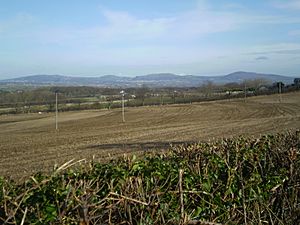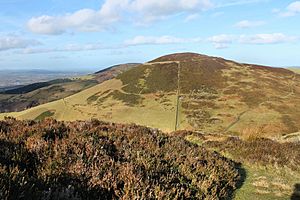Clwydian Range facts for kids
The Clwydian Range (called Bryniau Clwyd in Welsh) is a chain of hills in northeast Wales. It stretches from Llandegla in the south all the way to Prestatyn in the north. The tallest and most famous hill is Moel Famau. These hills are part of a special protected area called the Clwydian Range and Dee Valley Area of Outstanding Natural Beauty.

Contents
How the Hills Were Formed
The Clwydian Hills were created from ancient deep sea mud and sand. These materials settled on the seabed during the Silurian period, which was about 443 to 419 million years ago! Over time, these layers of mud and sand turned into mudstones and sandstones.
The hills are also shaped by huge cracks in the Earth's crust called faults. The biggest one, the Vale of Clwyd Fault, caused the impressive steep western side of the range. During the last ice age, a massive sheet of ice moved over these hills. As the ice melted, it carved out valleys and channels, like the one where the River Wheeler flows today.
Exploring the Hills
The tops of the Clwydian Hills offer amazing views. You can see far across northern Wales to the tall peaks of Snowdonia. Look east, and you might spot the Cheshire Plain and even the Peak District. On a clear day, you can even see Manchester and Liverpool in England!
The hilltops are covered in purple heather, while the lower slopes have green pastures. A famous walking path called the Offa’s Dyke National Trail goes right through the range, from Llandegla to Prestatyn.
Ancient Hillforts and Legends
Many of the hills in the Clwydian Range have ancient Iron Age hillforts on their summits. These were like old castles or forts built on high ground for protection. Some of these include:
- Y Foel (Moel Hiraddug)
- Moel-y-gaer
- Penycloddiau
- Moel Arthur
- Another Moel y Gaer
- Foel Fenlli
Just like in many parts of Britain, there are old stories and legends about King Arthur connected to these hills. You can also find ancient burial mounds, called tumuli, and piles of stones, known as cairns, on the hills.
A Special Protected Area
The Clwydian Range was named an Area of Outstanding Natural Beauty (AONB) in 1985. This means it's a very special landscape that needs to be protected. It was one of only five such areas in Wales at the time.
In 2011, the AONB was made even bigger. It now includes the beautiful Dee Valley, Moel y Gamelin, the Horseshoe Pass, and the ruins of Castell Dinas Brân. It also covers the towns of Llangollen and Corwen, the amazing Pontcysyllte Aqueduct, Chirk Castle, and Valle Crucis Abbey. The AONB is now about 389 square kilometers (150 square miles) in size!
Amazing Wildlife
The Clwydian Range is home to lots of different animals. You might spot red kites soaring overhead or red foxes hunting for rabbits and voles. It's also one of the few places in Wales where you can find the Black Grouse, a special type of bird.
There are projects working to protect animals like the European water vole, whose numbers have dropped a lot across the UK. Another project is trying to remove a plant called Himalayan balsam from the Alyn Valley. This plant isn't native to the area and can harm local plants.
Fun Things to Do
The Clwydian Range is a great place for outdoor activities.
- The Offa's Dyke Path, a long-distance walking trail, follows the range.
- The Clwydian Way is another long footpath that goes through the hills.
- The North Wales Path runs along the bottom of the steep western side, between Prestatyn and Dyserth.
Tallest Peaks
Here are some of the main peaks in the Clwydian Range:
| # | Peak | Height (m) |
|---|---|---|
| 1 | Bryn Coed yr Esgob | 211 |
| 2 | Moel Hiraddug | 265 |
| 3 | Mynydd y Cwm | 300 |
| 4 | Moel Maenfa | 290 |
| 5 | Moel y Parc | 381 |
| 6 | Penycloddiau | 440 |
| 7 | Moel Plas-yw | 420 |
| 8 | Moel Arthur | 456 |
| 9 | Moel Llys-y-coed | 465 |
| 10 | Moel Dywyll | 475 |
| 11 | Moel Famau | 554 |
| 12 | Moel y Gaer | 339 |
| 13 | Moel Fenlli | 511 |
| 14 | Moel Eithinen | 434 |
| 15 | Gyrn | 384 |
| 16 | Moel Gyw | 467 |
| 17 | Moel Llanfair | 447 |
| 18 | Moel y Plâs | 440 |
| 19 | Moel y Gelli | 361 |
| 20 | Moel y Waun | 412 |
| 21 | Moel yr Acre | 400 |
Images for kids


